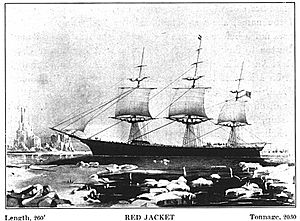Red Jacket (clipper) facts for kids
Red Jacket was a very famous clipper ship, known for being one of the biggest and fastest ever built. She was also the first ship to be part of the White Star Line company, which later became famous for building the Titanic. The ship was named after Sagoyewatha, a respected chief of the Seneca tribe, who was called "Red Jacket" by settlers.
Red Jacket was designed by Samuel Hartt Pook and built by George Thomas in Rockland, Maine. She was launched in 1853. This was the last ship ever built at that shipyard.

The clipper ship Red Jacket
|
|
Quick facts for kids History |
|
|---|---|
| Name | Red Jacket |
| Owner | Seccomb & Taylor, Boston |
| Builder | George Thomas, Rockland, ME |
| Launched | 2 Nov 1853 |
| Owner | Pilkington & Wilson |
| Operator | White Star Line |
| Acquired | 1854 |
| Notes | Used for immigrant trade; later became an Australian and Indian coastal freighter, 1861. |
| Owner | Wilson & Chambers, Liverpool, 1868 |
| Owner | Blandy Brothers, Madeira Islands |
| Acquired | 1883 |
| Fate | Driven ashore in a gale, 1885. |
| Notes | Became a hulk (a ship used as a floating storage), then a coal barge in the Cape Verde Islands. |
| General characteristics | |
| Class and type | Clipper, designed by Samuel Hartt Pook |
| Tons burthen | 2305 tons |
| Length | 251 ft. 2 in. (about 76.5 meters) |
| Beam | 44 ft. (about 13.4 meters) |
| Draft | 31 ft. (about 9.4 meters) |
Contents
Amazing Journeys of the Red Jacket
The Red Jacket was famous for its incredible speed and the many voyages it made across the world.
Setting a Speed Record
On her very first trip, Red Jacket made history! She set a new speed record for sailing ships crossing the Atlantic Ocean. She traveled from New York to Liverpool in just 13 days, 1 hour, and 25 minutes. This was measured from dock to dock, which was incredibly fast for the time.
The ship started its journey from Rockland by being towed. It was fully prepared for sailing in New York. The captain was Asa Eldridge, a very experienced commander from Yarmouth, Massachusetts. The ship had a large crew of 65 sailors. During the trip to Liverpool, the ship often sailed at an average speed of 14.5 knots (about 27 km/h). Sometimes, it even reached bursts of 17 knots (about 31.5 km/h)!
When Red Jacket arrived in Liverpool, a steamship from the Collins Line, which had left New York two days earlier, reported that Red Jacket was right behind them. As the clipper entered the harbor, tugboats tried to attach ropes to help guide it. But the Red Jacket was moving too fast! Thousands of people, who had heard about the ship's amazing speed, watched. Captain Eldridge skillfully slowed the ship down and backed it right into its docking spot.
Voyages to Australia
After its record-breaking trip, Red Jacket had its bottom covered with copper to protect it. New cabins were also added for passengers traveling to Australia. In 1854, the ship was bought by Pilkington & Wilcox and other investors in Liverpool. It was then rented by the White Star Line for a trip to Melbourne, Australia.
Under Captain Samuel Reid, Red Jacket reached Melbourne in just 69 days. Only one other clipper, the James Baines, ever made the trip faster. On June 13, 1859, while sailing from Liverpool to Melbourne, Red Jacket accidentally crashed into another British ship called Elizabeth Walker. The Elizabeth Walker sank, but Red Jacket bravely rescued all of its crew members.
Later Life as a Freighter
Red Jacket continued to carry immigrants until 1867. After that, she became a freighter, carrying goods along the coasts of Australia and India. In May 1871, the ship ran aground (got stuck on the seabed) near Cantick Head in the Orkney Islands. This happened while she was on a trip from Calcutta to Dundee. Luckily, she was refloated and was able to finish her journey.
The Ship's Final Journey
In 1872, Red Jacket started carrying lumber from Quebec to London. She joined other famous clipper ships like Marco Polo and Donald McKay, which also ended their careers carrying timber across the Atlantic.
In 1878, Red Jacket was involved in another collision with a ship called Eliza Walker, which sank. Again, Red Jacket rescued the crew. On January 29, 1878, the ship arrived in Plymouth, Devon, leaking water. Her crew refused to continue the voyage. At this time, she was recorded as a collier, meaning she was carrying coal from Newcastle upon Tyne to Genoa, Italy.
In 1883, Red Jacket was sold to Blandy Brothers, a Portuguese shipping company in the Madeira Islands. She was turned into a coaling hulk, which is an old ship used for storing coal. Her long and adventurous life came to an end on December 16, 1885. During a strong storm, she dragged her anchors and was driven ashore. The remains of the ship were later sold for a very small amount of money.
Images for kids


